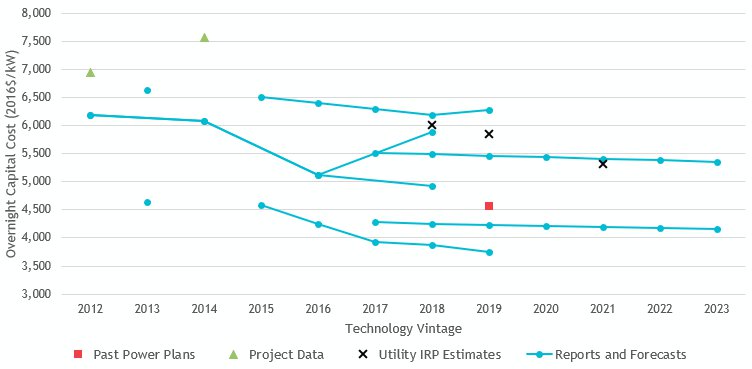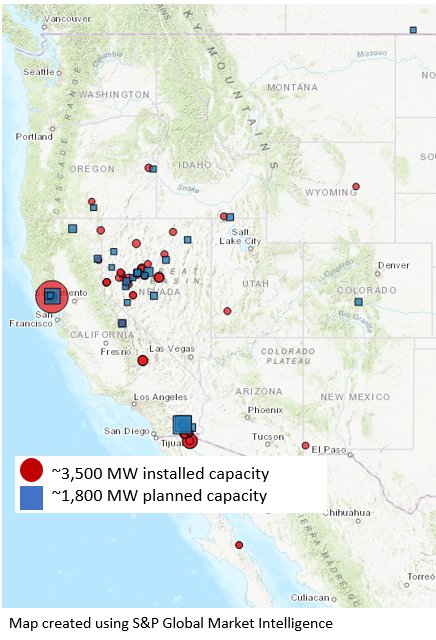Conventional Geothermal
Jump to: Considerations, Trends, and Resource Potential | Description of Reference Plant
The Pacific Northwest is home to a significant, naturally occurring geothermal resource – especially in Southern Oregon and Idaho – and yet, development has been limited so far. Conventional geothermal is a resource that requires the natural occurrence of heat + water + permeability beneath the earth’s surface. In contrast, enhanced geothermal systems (EGS) only require heat – the fluid and permeability are engineered – and therefore the technical and developable potential are considerably greater (see emerging technologies for more information on EGS).
Conventional geothermal is a renewable, clean energy resource with zero or low carbon emissions – depending on the technology used (flash steam technology emits minimal excess steam; dry steam and binary cycle emit zero emissions). The policy landscape favors geothermal electricity as it is a qualifying resource for compliance with renewable portfolio standards (RPS) and clean energy policies. In addition, geothermal qualifies for the Investment Tax Credit (ITC), a one-time tax incentive that can be claimed on corporate income taxes for a percentage credit of the cost of the project.
Conventional Geothermal Trends, Considerations, and Resource Potential
Jump to: Technology Trends | Cost Trends | Development Trends | Environmental Effects | Resource Potential in Region | Opportunities and Challenges
The following section describes high level trends in technology, cost, and development for conventional geothermal. In addition, it identifies resource potential in the region, opportunities and challenges, and environmental effects.
There are three major technology options when developing conventional geothermal – dry steam, flash steam, and binary cycle. Dry steam technology relies on steam directly from the production well to turn the turbine and drive the generator. Flash steam, the most common technology, uses a tank at the surface to rapidly vaporize (flash) the fluid into a steam which then turns the turbine and drives the generator. Binary cycle technology implements a closed-loop system in which the geothermal fluid and a lower-boiling point fluid are passed through a heat exchanger, causing the secondary fluid to flash to vapor. This steam from the secondary fluid is then passed through to the turbine and generator and no geothermal fluid ever comes into contact with the surface – all but eliminating emissions.
Major Conventional Geothermal Technologies

*Image Source: US DOE
Of the 14 gigawatts of geothermal installed globally, about 60% are flash steam, 25% are dry steam, and 15% are binary cycle. Depending on the resource temperature on-site, flash steam or binary cycle geothermal technologies could be used with the liquid-dominated hydrothermal resources of the Pacific Northwest. A preference for binary cycle seems to be emerging because of its modularity, applicability to lower temperature hydrothermal resources, and the environmental advantages of a closed geothermal-fluid cycle. In addition, binary-cycle releases no carbon dioxide, whereas flash-steam releases a small amount of naturally occurring carbon dioxide from the geothermal fluid.
Deciphering cost trends for geothermal projects is a tricky as the costs are extremely site- and technology- specific. There is considerable variation in exploration and drilling costs, dependent on the successful completion of wells with limited dry holes (drilled holes without the presence of water, rendering them useless for conventional geothermal). There is also variation in cost among the different geothermal resource technologies, with binary tending to be more expensive than flash technologies. Thus, there are limited (if any) improvements in cost over the past decade or so. However, technological advances being developed to explore and harness the potential of enhanced geothermal systems (see emerging technology), may help lower risk and reduce the cost of conventional geothermal in the future.
The figure below shows the data plots and analysis that were used to develop the 2021 Power Plan reference plant cost estimates. Note that this figure captures data from various conventional geothermal capacities, configurations, and technologies (including binary and flash-steam).
Overnight Capital Cost of Conventional Geothermal

By the end of 2020, there were about 3,500 megawatts of conventional geothermal installed in the western United States with an additional 1,800 planned capacity – either at existing or new sites. Of the more recent developments, the majority of installations have utilized binary technology. One interesting development is the Tungsten Mountain Geothermal Development project in Nevada, which is a hybrid geothermal and on-site solar PV project. The solar PV helps to offset the parasitic load (the load generated by the use of the equipment) and increase the overall power output at the site.
Conventional Geothermal Plants in Operation and Planned

* Map created using S&P Global Market Intelligence
See the Environmental Effects of Generating Resources for a high-level summary of some of the primary environmental effects of geothermal. For an in-depth description of the lifecycle impacts associated with electricity generation, see Appendix I of the Seventh Power Plan.
The conventional geothermal plant considered and assessed by the Council for the 2021 Power Plan are assumed to comply with existing environmental regulations governing air and water emissions, siting regulations, waste disposal, and fish and wildlife protection and mitigation costs when quantifiable and directly attributable to the new resource. Extensive environmental impact statements throughout the siting and licensing process as authorized by FERC are accounted for in the overall project cost. For more information, see the section on Federal Statutes and Regulation Updates and the Methodology for Determining Quantifiable Environmental Costs and Benefits and Due Consideration.
Resource Potential in the Region
The Pacific Northwest has considerable geothermal potential, in particular Southern Oregon and Idaho. A 2008 United States Geological Survey (USGS) analysis of the electric production potential of moderate (90° to 150° Celsius) and high (greater than 150° Celsius) temperature hydrothermal resources found that on average, there are over 9,000 megawatts of identified geothermal resource potential (known naturally occurring sites, for example surface manifestations like geysers that indicate the presence of geothermal activity) across the Western United States. Further, there is an additional 33,000 megawatts geothermal potential categorized as undiscovered resources – identified through geographic information system (GIS) mapping of geological factors that indicate the formation of geothermal systems. About 10% of the identified potential and 16% of the undiscovered potential are located within the region. (See emerging technologies for the enhanced geothermal systems potential identified.)
2008 USGS Map of Identified and Undiscovered Geothermal Resources

Delving into the region’s potential further, the following tables show the mean (average) and F95 (there is a 95% chance of at least the amount specified) of each PNW state, as identified by the 2008 USGS report. For a discussion on Enhanced Geothermal System (EGS) potential, see Emerging Technologies.
Mean Potential of Geothermal in the Region
| Identified Resources (MW) | Undiscovered Resources (MW) | Enhanced Geothermal System Resources (EGS) | |
| Idaho | 366 | 2,059 | 74,690 |
| Montana | 65 | 848 | 18,590 |
| Oregon | 594 | 2,082 | 68,640 |
| Washington | 25 | 330 | 7,150 |
| Regional total | 1,050 MW | 5,319 MW | 169,070 MW |
*Data source: USGS Assessment of Moderate- and High-Temperature Geothermal Resources of the US, 2008
F95 Potential of Geothermal in the Region
| Identified Resources (MW) | Undiscovered Resources (MW) | Enhanced Geothermal System Resources (EGS) | |
| Idaho | 89 | 470 | 52,250 |
| Montana | 17 | 194 | 9,900 |
| Oregon | 179 | 475 | 47,960 |
| Washington | 8 | 75 | 4,290 |
| Regional total | 293 MW | 1,214 MW | 114,400 MW |
*Data source: USGS Assessment of Moderate- and High-Temperature Geothermal Resources of the US, 2008
Of the identified geothermal resource potential, the majority is located in Oregon, while the undiscovered resource is largely split across Oregon, Idaho and some in Washington. There is minimal potential in Montana.
Conventional Geothermal Potential Across the PNW States

Geothermal has many benefits that complement the existing and evolving power system. Geothermal is a renewable, clean energy resource with a high capacity factor (80-90% depending on the technology) and a reliable, consistent output. In addition, with no reliance on variable fuel prices, there are low, predictable operating costs.
On the other hand, the development of a geothermal project can very challenging and expensive. There is a high risk involved in the extremely complex and expensive exploration of a geothermal site, where holes are drilled to assess the temperature, permeability, and presence of water at various depths. The cost of exploration and the initial testing of a geothermal site can equal about 30-60% of the typical project cost, however a developer requires capital before they are able to confirm the resource potential and yield a return on investment. This dynamic between the significant upfront capital investment and uncertainty over successful exploration can lead to challenges in funding and developing projects. Finally, there is the risk of induced seismicity when developing a geothermal project, although mitigation protocols are established to minimize this occurrence.
Description of Conventional Geothermal Reference Plant
The conventional geothermal reference plant is assumed to use closed-loop organic Rankine cycle binary technology suitable for low geothermal fluid temperatures abundant across Oregon and Idaho. The plant includes production and injection wells, geothermal fluid piping, power block, cooling towers, step-up transformers, switchgear and interconnection facilities, and security, control, and maintenance facilities.
Conventional Geothermal: 2021 Power Plan Reference Plants
| Reference Plant | Conventional Geothermal |
| Technology Type | Binary, closed-loop |
| Configuration | |
| Nameplate Capacity (MW) | 22 MW |
| Location | East of the Cascades |
| Avg. Annual Capacity Factor | 80% |
| Round-trip Efficiency | – |
| Heat Rate – HHV (Btu/kWh) | – |
| Economic Life (Years) | 30 |
| Tax Benefits | ITC |
| Financial Sponsor | IOU |
| Development Period (Yrs) | 4 |
| Construction Period (Yrs) | 3 |
| Earliest In-Operation Date | 2021 |
| Overnight Capital Cost ($/kW) | $5,400/kW |
| All-in Capital Cost (pre-tax benefits) ($/kW) | $6,528/kW |
| All-in Capital Cost (w/ tax benefits) ($/kW) | $5,875/kW |
| Fixed O&M Cost ($/kW-yr) | $150/kW-yr |
| Variable O&M Cost ($/MWh) | $5/MWh |
| Transmission | BPA P2P Long-term Firm |
| Deferred Transmission and Distribution ($/kW-yr) | – |
| Maximum buildout (MW) | 462 MW (22 units) |
*All costs in 2016 year dollars. For more details and definitions of resource attributes, see Definitions of Reference Plant Components.
Maximum buildout: The maximum potential for conventional geothermal in the region is set at 462 megawatts. This estimate is based on the identified conventional geothermal potential in the 2008 USGS assessment (293 MW capacity at 95 percent confidence) plus a percentage (15%) of the undiscovered potential (1214 MW * 0.15 = 182 MW), rounded down to equal 22 reference plants. The 15 percent discount of the undiscovered potential takes into account the limited development in the Northwest to date, the high frequency of dry holes encountered during earlier attempts to develop Northwest geothermal resources, the high risk and long lead time, and the relatively few sites currently under exploration/development. This is the same assumption that was used in the Seventh Power Plan, and there has been limited activity since then. See conventional geothermal potential in the region for more (above) for more details on the USGS assessment.
Forward capital cost curves: Due to the site-specific nature of conventional geothermal resource development, there is no cost improvement applied to the reference plant over the planning horizon. In other words, the costs identified can be viewed as estimates within a range of expected new development costs over the next few decades.
Forward capacity factor improvements: No capacity factor improvement multiplier is applied to the conventional geothermal reference plant. New technological advances (enhanced geothermal systems, for example) may produce higher outputs in the future, but those are not directly comparable with the existing binary technology represented in this plan.
More information: For background analysis, see the initial presentation on conventional geothermal from the January 2020 GRAC meeting. Please note that some of the material in the presentation may have been updated between that meeting and the draft plan. In addition, see the capital/FOM/VOM cost workbooks for all resource reference plants as well as MicroFin for supplementary inputs and analysis.



